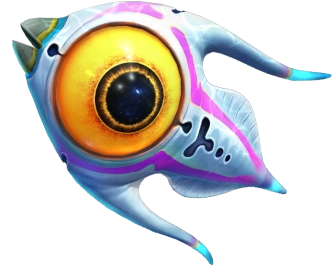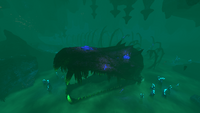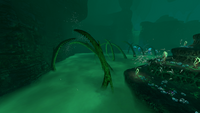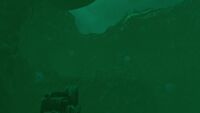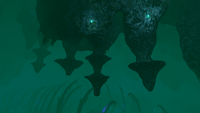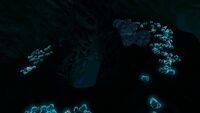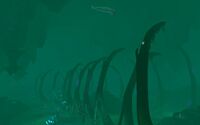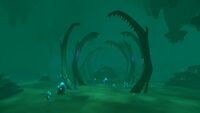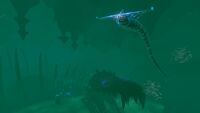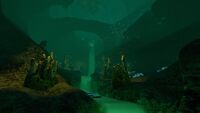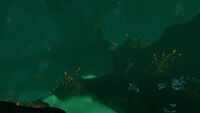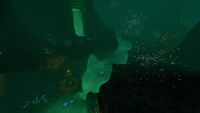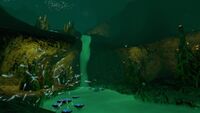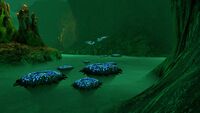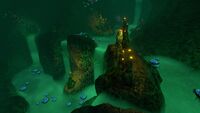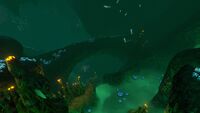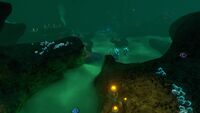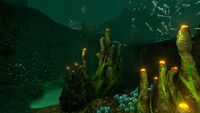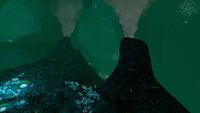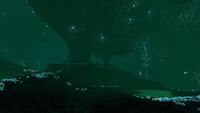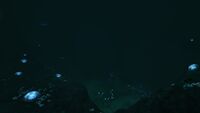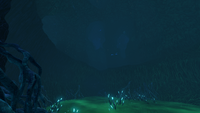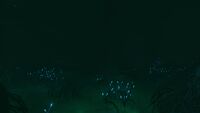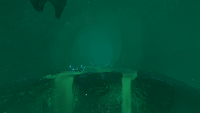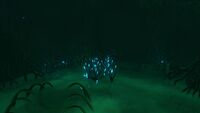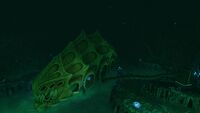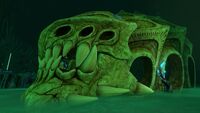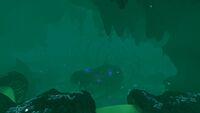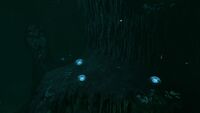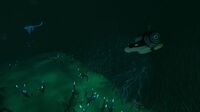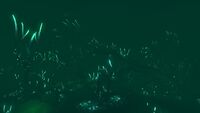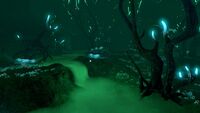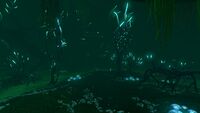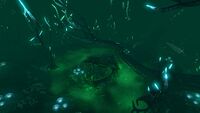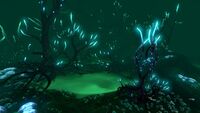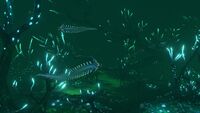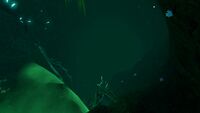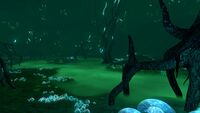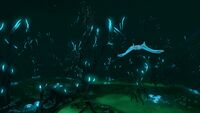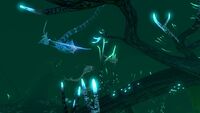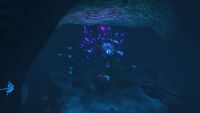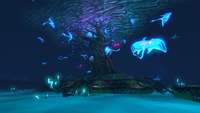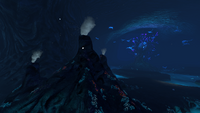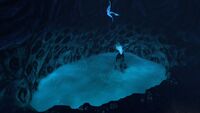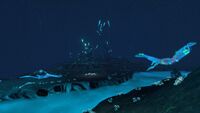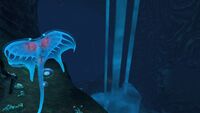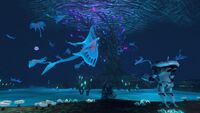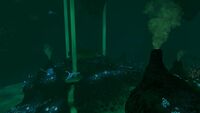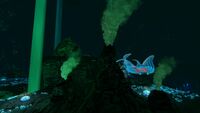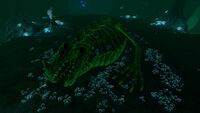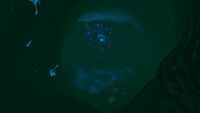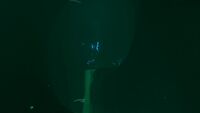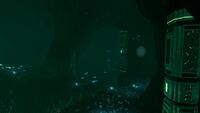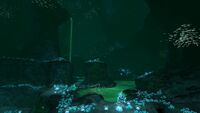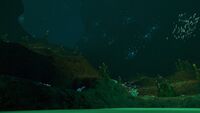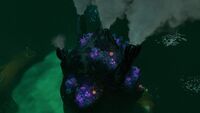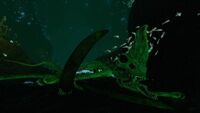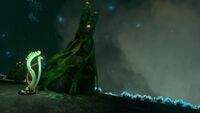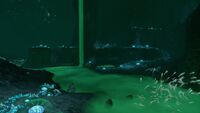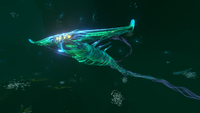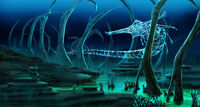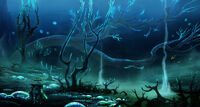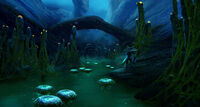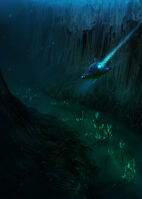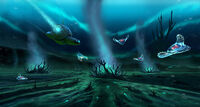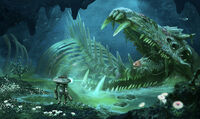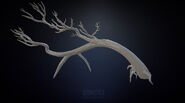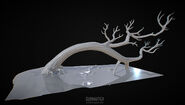
|
Read at own risk This article contains unmarked spoilers. Players new to the game would want to avoid or be cautious toward this article. |
Terrain scans indicate this biome contains unusually high concentrations of organic and fossilized remains.
― PDA, Dialogue
The Lost River is a massive, frigid cave biome located deep under the surface and is further divided into seven distinct sub-biomes.
There are four entrances to the Lost River. These entrances to the Lost River can be found in the Northern Blood Kelp Zone, the Deep Grand Reef, the border between the Mountains and the Bulb Zone, and the Blood Kelp Trench. The Cyclops is able to enter the Lost River through all four entrances, and can traverse the whole way into the Inactive Lava Zone. The Seamoth can travel through all passages, but is unable to travel to the Lava zones.
It is the deepest biome that can be explored by the Seamoth, although some sectors do dip below its maximum depth and the green brine will also wear down its durability.
Description
The Lost River is a vast, gloomy biome, possessing a distinct greenish tint in the water that is mostly illuminated by the alkaline brine pools. It has an eerie atmosphere amplified by the abundance of hostile fauna, ghostly flora, and the many hazardous environmental features.
Vast amounts of green brine pools cover almost all of the lower portions of the caverns. The brine pools found throughout most of the cave system will harm the player upon direct contact, with the exception being while within the Prawn Suit, or when within the harmless blue brine found within the Tree Cove. The brine pools do damage to the Seamoth as well. Fauna and flora found within the Lost River are immune to the brine, a trait carried only by them.
The Disease Research Facility is located in the Lost River, inside a cavern with its opening in the Junction and the Mountains corridor. Large alien column structures can be used as waypoints to locate the facility.
The Lost River is one of the coldest biomes implemented, with temperatures on the sea floor rarely rising above 10 degrees Celsius. Hence, thermal reactor modules do not work very well here.
If you wish to build a Seabase in the Lost River, a Thermal Plant next to a thermal vent is one of the best ways to power a base in this biome. It is advised to bring plenty of Titanium with the player, since there are few large Titanium deposits there. Any other resource can usually be acquired on the spot. Note that there is enough resources, like lead, in the lost river for the player, for them to build a nuclear reactor and nuclear reactor rods. Additionally, be conscious of the hull integrity so that the Seabase does not take any damage.
A player can attempt to park their Cyclops above a thermal vent in order to charge it with a Cyclops thermal reactor module. However, be careful so that the exit hatch is not near the vent.
The Lost River is composed of seven distinct areas, each holding similar resources, but some more dangerous than others:
Bone Fields
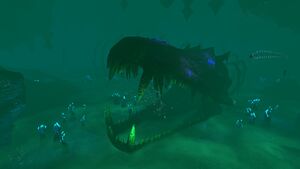
"Bone Fields"
The Bone Fields is a vast cavern within the Lost River, centered on the Gargantuan Fossil which gives the Bone Fields its name. It is connected to the Blood Kelp Trench via the Lost River Corridor, and to the Deep Grand Reef via the Ghost Canyon, each of them having their own flora and particular landscapes.
The Ghost Leviathan Juvenile in this region is facing directly to the Ghost Canyon. One should be cautious when entering through there to here.
There are a few hydrothermal vents in this area. On these you can find Rubies, Lithium, Green Table Coral and sometimes Magnetite.
Large Resource Deposits are present mostly under the brine lake surrounding the colossal skeleton and the caves underneath. Rarer deposits can be found in the Bone Fields Caves in the ceiling, others around the cavern and deeper caverns under the brine.
The caves in the brine and ceiling contain a unique, unnamed kind of coral.
Gallery
Corridor
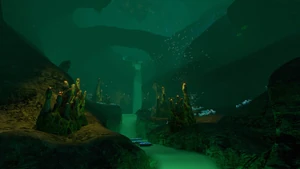
"Corridor"
The Lost River Corridor is the area connecting the Bone Fields to the Blood Kelp Trench. It is mainly populated by Crabsquids, with strange rock structures covered by Pyrocoral growing on the sides.
A good amount of Limestone Outcrops can be found on the seabed, with Shale Outcrops occasionally located on the walls and ceiling of the corridor. There is a group of hydrothermal vents at the end of the corridor, marking the entrance to the Bone Fields.
Gel Sacks can also be found in abundance scattered around the edge of the brine streams.
Gallery
Ghost Canyon
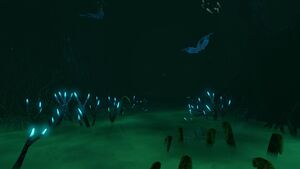
"Ghost Canyon"
The Ghost Canyon is a large passage featuring multiple caves and tunnels branching out from one huge "canyon". It is connected to the Bone Fields from the south. Numerous roots and bioluminescent-tipped branches litter the sides and bottom of the brine-filled trenches.
The Lost River Laboratory Cache, a small Precursor site that was set up to study an Ancient Skeleton, can be found here.
This area serves as the entrance to the Lost River from the Deep Grand Reef.
Gallery
Ghost Forest
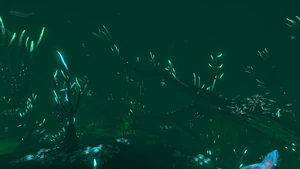
"Ghost Forest"
The Ghost Forest is a massive cavern serving as one of the entrance areas of the Lost River (located in the Northern Blood Kelp Zone).
The cavern is greatly populated by whitish glowing flora on the sea floor, as well as the snaking dark branches of bioluminescent Ghost Trees. It is the starting point of the brine river, and brinefalls of various sizes are present within the area. In the main cavern a smaller example of the Gargantuan Fossil skull can be found, presumably from a juvenile.
Among the dense branches, predators such as River Prowlers and Blood Crawlers lurk. This area is also one of the three locations in the Lost River where a Ghost Leviathan Juvenile resides. The Ghost Leviathan is present in the upper area of the Ghost Forest, along with the River Prowlers. The lower section is mostly safe, only containing Blood Crawlers.
Most of the resources in this cavern can be found either inside the brine rivers, such as Large Resource Deposits, Lithium or Magnetite, or around them, like Gel Sacks, Quartz or Sandstone Outcrops.
An Alien Arch Cache is present in this area, serving as a warp gate to the Primary Containment Facility. It is close to the juvenile Ghost Leviathan.
There is a near-vertical drop-off down a narrow tunnel just large enough for the Cyclops at the back end of the cavern that leads down to the Junction.
Gallery
Tree Cove
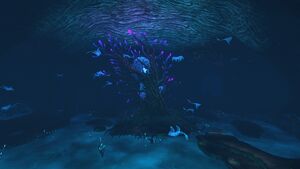
"Tree Cove"
The Tree Cove is a large cavern within the Lost River. The brine river forms a large lake here, with the luminous Giant Cove Tree in its center. However, the color of the brine is a bright blue, rather than the corrosive green of the other sections of the Lost River. The blue brine does not damage the player.
One end of the cavern opens to the northern passage leading to the Junction, and the other, behind the tree, spirals downwards, leading to the Inactive Lava Zone Corridor. Roots and branches grow scattered on the brine lakes and numerous Ghostrays inhabit the chamber. This part of the Lost River is the safest sub biome in Subnautica. This is because the blue brine does not harm the player, there is only one fauna species (which is passive), and there is no flora which can harm the player besides Deep Shrooms.
Gallery
Junction
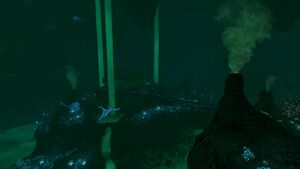
"Junction"
The Junction is characterised by a large plateau surrounded by a ring of brine. At the top of the plateau are several hydrothermal vents, with some Green Table Coral and Rubies scattered around them. The Sea Dragon Leviathan skeleton can be found here, next to the thermal vents.
Most of the Large Resource Deposits can be found under the brine, with the exception of Lead, Quartz and Titanium that surround the pools along with Limestone Outcrops and rarely Uraninite Crystals. The small portion connecting this area with the Bone Fields contains only Crystalline Sulfur under the brine, however.
There is also a naturally formed bridge that connects the plateau to the northern side of the cavern, towards the Ghost Forest. Brine falls from the north and south flow into the brine here, which contains some ghost trees and roots. The Junction connects to the Bones Fields to the south, the Ghost Forest to the north, and the Tree Cove to the west. The Mountains Corridor is to the east, where the Disease Research Facility is found.
Gallery
Mountains Corridor
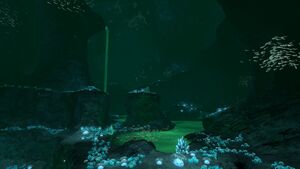
"Mountains Corridor"
The Mountains Corridor is a large tunnel leading from the Disease Research Facility cave to the Mountains and the Bulb Zone. In-between the DRF Cave and Mountains entrance is the large pit that drops into the Inactive Lava Zone. This cave features many glowing lights on the ceiling, as well as hydrothermal vents and Skeletal Remains. One Ghost Leviathan Juvenile can be found in the tunnel, above the Inactive Lava Zone entrance.
Gallery
Lost River Concept Art
Models
Trivia
- Like other segmented biomes (such as the Inactive Lava Zone), the Lost River's technical data divides it into the LostRiver_TreeCove, LostRiver_BonesField, LostRiver_Canyon, LostRiver_Junction, LostRiver_GhostTree and LostRiver_Corridor for both corridors. This aids the AI in deciding music tracks, random events, and creature behavior.
- The damage from the brine may be possible implementation/reference to the "Pillars of Silence" concept art, where enormous jets of acid dot an alien seabed.
- The brine used to be able to harm the Blood Crawler, Gel Sack, and Ghost Weed due to an oversight of not having the immunity to it.
- The Ghost Forest was originally known as the "Ghost Trees Chamber" before the Bones Update.[1]
References
- ↑ http://unknownworlds.com/subnautica/bones-update/ Dated October 27, 2016.
